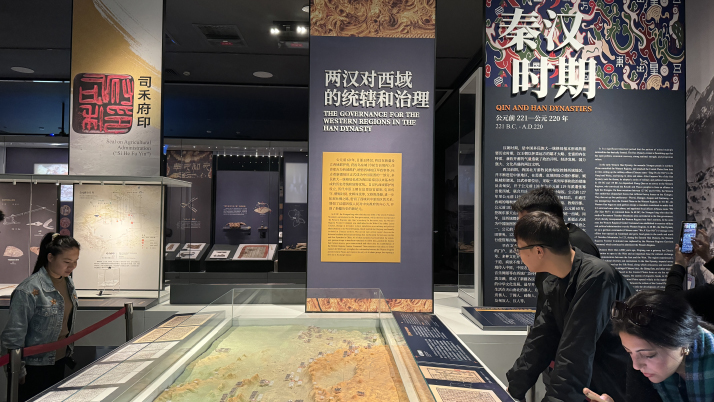| Xinjiang Today |
| Cultural powerhouse in the making | |
|
|
 Visitors learn about the Han Dynasty's governance of Xinjiang, then known as the Western Regions, at the Xinjiang Uygur Autonomous Region Museum in Urumqi on October 25, 2024. The Han Dynasty ruled China from 202 B.C. to A.D. 220 (SHI GANG)
Xinjiang Uygur Autonomous Region is not only renowned for its majestic mountains, rivers and deserts, but is also steeped in history and culture. We must give prominence to the cultural enrichment of Xinjiang by transforming the region's rich cultural resources into a strong driving force for development. This will pave the way for advancing Chinese modernization, the country's development strategy leading up to the mid-21st century, in its largest provincial-level region. The Chinese Government has established a strategy for the governance of Xinjiang with the following guidelines: governing Xinjiang in accordance with the law, maintaining stability in the region through ethnic unity, nourishing the cultures of Xinjiang, promoting prosperity among the local population, and developing Xinjiang from a long-term perspective. Among them, cultural nourishment plays a key role in winning the hearts and minds of the people. Xinjiang's initiative of building itself into a region with a strong cultural sector aligns with this principle. A people-centered approach As we pursue the abovementioned strategy, we must follow the guidance of Xi Jinping Thought on Socialism with Chinese Characteristics for a New Era, which outlines China's vision for governance under President Xi's leadership, especially his thoughts on cultural development. Cultural development must follow a people-centered philosophy and emphasize maximizing the vitality of innovation and creativity. Cultural initiatives, acting both as a unifying force and a driver of societal wellbeing, must focus on enhancing the availability of diverse, high-quality cultural services and products. This approach ensures that the wide-ranging and evolving intellectual and cultural needs of the population are met. By prioritizing social benefits while aligning them with economic objectives, a balanced framework for progress must be established. To build a dynamic cultural ecosystem, we must nurture originality, embrace technological integration and transform cultural resources into strategic advantages. Taking these steps will lay the foundation for sustainable, high-quality advancement in cultural programs and industries. We must also focus on enhancing cultural identity and promoting the inheritance of China's outstanding traditional culture. It is essential to recognize that cultural identity forms the deepest level of unity and serves as the root of ethnic solidarity and harmony. China's traditional culture embodies the essence of Chinese civilization, acting as the enduring heritage for all ethnic groups residing in Xinjiang. It has always been the fertile soil for cultural development. To strengthen this identity, efforts must prioritize the cultural confidence of the Chinese nation, emphasizing its distinctive features and symbols. Walk the talk It is essential to draw on the history of the interaction, exchange and integration among people from different ethnic backgrounds in Xinjiang, as well as look into the region's development throughout different historical periods. The purpose is to promote a wider knowledge of Xinjiang's cultural heritage. This includes shared traditional culture, culture specific to each ethnic group, revolutionary culture, reclamation culture, i.e. government-led efforts to cultivate and guard border areas, and Silk Road culture. We need to strengthen the preservation of cultural monuments and intangible cultural heritage such as performing arts and festive events. We should also make the most of Xinjiang's cultural heritage to better inform the public of the region's history and why it is part of Chinese history. We should promote the integration of culture and tourism. Artists should be encouraged to create works that accurately reflect Xinjiang's history, embody Chinese cultural heritage and modern progress, and resonate with public appreciation. We will drive high-quality growth in cultural tourism, which has been recognized as one of Xinjiang's top 10 priority industry clusters for future development, enabling culture to enhance tourism and tourism to showcase culture. The cultural tourism sector should be synergized with urban renewal, rural revitalization and other initiatives aimed at improving people's wellbeing. The goal is to establish tourism as a pillar industry that boosts employment opportunities, benefits communities, and fosters exchange among all ethnic groups who call Xinjiang home. Given the often negative portrayal of Xinjiang in international media, it is necessary for the region to amplify its voice on the global stage. Xinjiang should engage in more international exchange and better communicate its narrative to a wider, global audience. The author is an associate professor at the School of Marxism, Xinjiang Institute of Engineering Comments to yanwei@cicgamericas.com |
|
||||||||||||||||||||||||||||||
|
